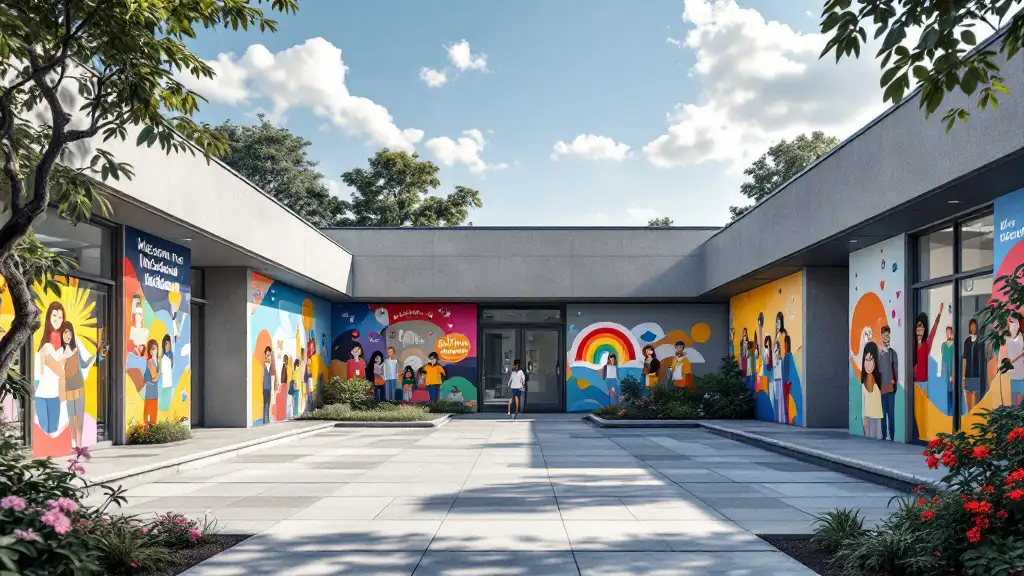How Sports Teams Can Be Inclusive Of Autistic Players
Championing Inclusion: The Role of Sports Teams in Autism Support
Sports offer a powerful avenue for social connection, skill development, and personal growth, especially for autistic individuals who often face unique challenges in social interaction and motor coordination. This article explores how sports teams can create welcoming environments that embrace autistic players, fostering wellbeing, inclusion, and skill enhancement through tailored programs and supportive community efforts.
Understanding Autism Spectrum Disorders and Motor Challenges
What Are the Characteristics of Autism Spectrum Disorders?
Autism spectrum disorders (ASD) are primarily identified by difficulties in social interaction and communication, alongside repetitive behaviors. Individuals with ASD often face challenges in engaging with others and expressing themselves effectively, which can impact their daily lives and social participation.
How Do Motor Disorders Impact Autism?
Recent research has highlighted that motor disorders are a significant aspect of autism. Many autistic individuals experience delays or impairments in motor coordination, balance, and strength. These motor challenges contribute to difficulties in physical activities and can affect the ability to participate fully in recreational or sports programs.
Why Is It Important to Address Motor Skills for Sports Inclusion?
Addressing motor skills is fundamental to promoting sports inclusion for people with autism. Developing motor abilities enhances participation, which in turn supports social interaction and communication skills. Tailoring sports programs to improve motor function helps reduce behavioral challenges and encourages engagement, making sports a powerful tool for overall development and well-being in autistic individuals.
The Multifaceted Benefits of Sports Participation for Autistic Individuals
What Are the Physical Benefits of Sports for Autism?
Sports participation can greatly enhance physical health in individuals with autism. Activities such as swimming, martial arts, horseback riding, and team sports improve motor coordination, balance, strength, and motor control. For example, a 12-week sensory integration-based sports training program demonstrated a significant 17.2-point increase in motor coordination scores (BOT-2) among children with autism. Improvements also extend to speed, agility, muscular strength, aiming, catching, and locomotor skills, enabling autistic children to engage more fully in everyday physical activities.
How Does Sports Participation Improve Psychological Well-Being?
Engaging in sports can foster psychological benefits including emotion regulation and increased self-efficacy. Specific interventions like yoga, tai chi, and aquatic training have shown positive effects on emotional control and mental well-being. Additionally, participation in structured sports programs has been linked with reductions in autism characteristics by up to 25%, reflecting improvements in overall psychological functioning. Physical exercise can also short-term reduce stereotypic behaviors, leading to better daily functioning.
How Do Team Sports Foster Social Development?
Playing team sports such as soccer offers important social benefits by enhancing communication and social skills. Peer-mediated interventions in soccer facilitate rapid acquisition and retention of skills, and inclusive recreational programs promote social interaction among participants with and without autism. Family involvement and animal-assisted activities like therapeutic horseback riding further support social engagement. Longitudinal studies indicate that participation in social sport programs enhances brain connectivity linked to communication and social processing.
Can Sports Help Reduce Stereotypic Behaviors?
Regular sports participation contributes to reductions in repetitive and stereotypic behaviors common in autism. Physical activities provide sensory stimulation and opportunities for social connection that redirect and decrease maladaptive behaviors. Improvements in social responsiveness scores of over 13 points have been documented following sensory integration-based sports training. The enjoyable and structured nature of sports helps establish routines that reduce anxiety-driven behaviors.
The evidence firmly supports sports as a multifaceted intervention that enhances physical fitness, psychological health, social skills, and behavioral outcomes in autistic individuals, promoting greater inclusion and quality of life.
Evidence Supporting Motor and Social Skill Improvements Through Sports
How do sports improve motor coordination, balance, and strength in individuals with autism?
Sports engagement in activities such as swimming, martial arts, horseback riding, dance, and team sports has been shown to significantly boost motor coordination, balance, and strength in individuals with autism spectrum disorder (ASD). These sports often incorporate diverse movement patterns and sensory stimulation, which address underlying motor disorders frequently observed in autism. For instance, a 12-week sensory integration-based sports training program engaging vestibular, proprioceptive, and tactile exercises led to a substantial increase in children's motor coordination, evidenced by a 17.2-point gain in standardized BOT-2 motor skill scores.
In what ways do sports enhance social communication skills in autistic individuals?
Participation in sports not only cultivates physical skills but also enhances social communication and interaction. Studies report that sports programs contribute to improved joint attention, expressive language, adaptive behaviors, and overall social responsiveness. These gains are often attributed to the structured social environments sports provide, promoting peer interaction and teamwork. For example, soccer programs that utilize buddy systems and peer-mediated interventions facilitate rapid acquisition of both sports and social skills among children with ASD. By fostering social engagement, sports activities help reduce stereotypic behaviors and promote emotional regulation.
What quantitative outcomes demonstrate the benefits of sports programs for motor and social skills?
Quantitative analyses from recent research demonstrate large effect sizes (Cohen’s d > 0.8) for improvements in both motor skills and social responsiveness following sport-based interventions. Specifically, a notable 13.2-point decrease in Social Responsiveness Scale (SRS-2) scores was observed after a structured sports training regimen, indicating enhanced social functioning. Participation metrics also reflect positive trends; for example, participation rates in structured activities rose from 45% to 85%, and engagement in group sports increased from 50% to 88%. These data underscore the effectiveness of sport-based programs in yielding measurable improvements in motor and social domains, crucial for promoting inclusion and long-term wellbeing for individuals with autism.
Tailoring Sports Programs to Meet Individual Needs

Why is personalization important in sports programs for autistic individuals?
Personalized sports activities are crucial because autism presents uniquely in each person, requiring tailored approaches that address individual strengths, challenges, and preferences. Customized programs can maximize engagement and effectiveness by aligning with each person's motor skills, social communication abilities, and behavior patterns.
How should sensory sensitivities influence program design?
Sensory sensitivities common in autism necessitate thoughtful adaptation of the environment. Adjustments may include controlling lighting to prevent harsh glare, minimizing background noise, and providing quiet spaces. Using familiar routines and visual supports can reduce anxiety and improve participation. Sensory-friendly equipment or activities that incorporate vestibular, proprioceptive, and tactile stimulation can further enhance comfort and skill development.
When should individual versus group sports be chosen?
Deciding between individual and group sports depends on the participant's social comfort and goals. Individual sports, such as swimming or yoga, may suit those needing a low-stimulation setting or focusing on personal skill development. Group or team sports, like soccer or basketball, offer valuable opportunities for social interaction and communication skill-building but may require additional supports, such as buddy systems or trained peers, to support inclusion.
What environmental adaptations support inclusion?
Environments should be adapted to meet sensory needs and promote accessibility. This includes selecting indoor or outdoor venues based on weather and sensory triggers, creating structured schedules to minimize unpredictability, and ensuring supportive staff are present. Collaboration with autistic individuals, families, and trained professionals helps tailor modifications effectively. Community involvement and manageable group sizes can foster a supportive atmosphere that encourages long-term engagement.
| Aspect | Considerations | Examples of Adaptations |
|---|---|---|
| Personalization | Individual strengths and challenges | Tailored activity selection and pacing |
| Sensory Sensitivities | Light, noise, tactile stimuli | Adjust lighting, reduce noise, use sensory tools |
| Sport Type | Social comfort, skill focus | Individual activities (yoga) vs. team sports (soccer) |
| Environmental Support | Accessibility and predictability | Visual schedules, quiet zones, trained instructors |
Tailored sports programs that recognize personal differences and sensory needs are foundational for promoting inclusion, skill development, and enjoyment among autistic individuals.
Diverse Sport Options Showing Positive Outcomes
What types of sports benefit individuals with autism?
Several diverse sports activities have been shown to provide significant benefits for people on the autism spectrum. These include swimming, martial arts, horseback riding, and dance, each contributing to improvements in motor coordination, balance, strength, and social communication. Participation in such sports not only enhances physical abilities but also supports emotional and social development.
How does aquatic training help autistic individuals?
Aquatic training, such as swimming, offers a unique sensory environment that can soothe and regulate sensory processing challenges common in autism. Immersion in water promotes balance, strength, and motor control. Additionally, it facilitates emotion regulation and social engagement, helping individuals feel comfortable and connected in a calming setting.
What are the benefits of tai chi and yoga for autism?
Tai chi and yoga emphasize controlled movement, breathing, and mindfulness, making them effective for improving motor skills and emotional regulation in autistic individuals. These activities enhance balance and body awareness while reducing anxiety, leading to better social interactions and overall well-being.
What role do animal-assisted interventions play?
Animal-assisted interventions, particularly horseback riding, have shown promising results in autism therapy. These programs boost motor skills through riding activities and promote emotional well-being by fostering companionship and interaction. Horseback riding combined with tailored support can help develop social skills and reduce stereotypic behaviors.
Collectively, these various sports and interventions provide multifaceted benefits, making them valuable components of autism support programs. Their adaptability and holistic approach encourage long-term engagement and promote physical, psychological, and social gains for individuals with autism.
Longitudinal Research Insights on Sport-Based Social Skills Enhancement
Sustained social and communication improvements
Longitudinal studies have consistently demonstrated that involvement in structured sports programs leads to sustained improvements in social skills and communication for individuals with autism spectrum disorders (ASD). Over time, regular sports participation contributes to better social interaction, increased expressive language abilities, and enhanced adaptive behaviors. These improvements often persist well beyond the conclusion of the training, underscoring the lasting benefits of such interventions.
Neurobiological changes linked to sports
Beyond observable behavioral gains, engaging in sports has been associated with measurable neurobiological changes in autistic individuals. MRI studies reveal that sports-based interventions can promote brain plasticity, aiding in the development of neural networks that support social and cognitive functions. This neuroplastic response is a crucial factor in the positive outcomes seen in social and communication domains.
Enhanced brain connectivity and white matter integrity
Further research highlights that participation in sports correlates with enhanced functional connectivity within the brain. In particular, white matter integrity—important for efficient neural communication—is improved following consistent physical activity and sports training. These brain changes are thought to underlie the improvements in social communication skills and emotional regulation observed in individuals with ASD who engage in well-designed sports programs.
Together, these findings provide compelling evidence that sport-based activities are not only beneficial at a behavioral level but also contribute to fundamental neurobiological enhancements that support long-term social and communicative development in autism.
The Role of Family and Community in Supporting Autistic Athletes
Family involvement in sports activities
Families play a crucial role in encouraging and sustaining sports participation among autistic individuals. Active family involvement can enhance social interactions and emotional well-being, providing a supportive environment that fosters motivation and confidence. Parents and caregivers often help tailor activities to meet individual sensory and communication needs, using strategies such as visual schedules and familiar routines to reduce stress and improve engagement. Their participation also offers emotional reassurance, making sports a more enjoyable and accessible experience for autistic athletes.
Community program engagement
Community-based sports programs create broader opportunities for social interaction and skill development. These programs often include adaptive sessions that accommodate sensory sensitivities and utilize peer-mediated interventions, which promote social inclusion and rapid skill acquisition. Community involvement also extends to local disability organizations that provide resources, funding, and training for sports instructors. This collaborative approach ensures that programs are inclusive and sensitive to autism traits while offering meaningful physical and social benefits. Additionally, community initiatives encourage the participation of both autistic and neurotypical peers, which helps generalize social skills and fosters a sense of belonging.
Animal-assisted therapy as social emotional support
Animal-assisted interventions, especially horseback riding, serve as valuable adjuncts in sports programs tailored for autistic individuals. These therapies enhance emotion regulation, social engagement, and motor coordination by providing calming sensory experiences and nonjudgmental companionship. The presence of animals encourages interaction and communication while supporting emotional well-being. Combined with family and community support, animal-assisted activities promote holistic development and help reduce social stigma, making them a vital component in comprehensive sports programs for autistic athletes.
Applied Behavior Analysis (ABA) Therapy and Its Intersection With Sports Programs
What is Applied Behavior Analysis (ABA) therapy, and how is it used in treating autism?
Applied Behavior Analysis (ABA) therapy is a scientifically grounded approach that focuses on understanding behavior by analyzing how environmental factors influence it. It seeks to increase helpful behaviors like communication, social interaction, and daily living skills, while reducing harmful or disruptive behaviors. Techniques such as positive reinforcement and careful analysis of antecedents and consequences are central to ABA's methods.
Use of ABA techniques in sports settings
In sports programs tailored for autistic individuals, ABA techniques can be used to enhance participation and skill acquisition. For example, ABA strategies like discrete trial training or using a buddy system can encourage engagement in activities such as soccer or martial arts. Positive reinforcement helps reinforce motor and social skills, while structured prompts guide learning in game rules and teamwork. These strategies allow individuals with autism to better navigate the challenges presented in group activities and benefit more fully from physical and social components of sports.
Complementary roles of ABA and sports interventions
ABA therapy and sports programs complement each other, offering overlapping but distinct benefits. While ABA provides a structured behavioral foundation to teach and support skill development, sports programs offer practical, enjoyable settings for applying those skills in real-world social and physical contexts. Participation in sports can reduce stereotypic behaviors and enhance motor coordination and social communication, outcomes that align with ABA goals. Regular sports practice, especially when ABA strategies are integrated, may lead to improved social responsiveness, motor skills, and increased social inclusion for individuals with autism. Optimizing this synergy requires individualized planning and collaboration between behavior analysts, sports instructors, families, and participants.
Providers of ABA Therapy and Their Contribution to Inclusive Sports
Who typically provides ABA therapy for individuals with autism?
ABA therapy is delivered by a team of highly trained professionals including board-certified behavior analysts (BCBAs), licensed behavior therapists, and registered behavior technicians (RBTs). These providers often work for specialized healthcare companies, clinics, or educational organizations dedicated to autism services.
Settings and delivery modes for ABA
The therapy can be administered across diverse settings such as the individual's home, educational environments, community centers, or through virtual platforms suited to the person’s unique requirements. This flexibility allows integration with various activities, including sports programs.
Collaboration with sports teams and families
Effective ABA therapy involves collaboration with families to tailor interventions to individual goals and promotes inclusion within sports teams. Therapists often work alongside coaches and recreational staff to adapt sports activities, using strategies like peer-mediated interventions or buddy systems to enhance skill development and participation for autistic individuals.
This multidisciplinary approach ensures that ABA techniques support behavioral and social gains within sports settings, fostering better engagement and inclusion for participants on the autism spectrum.
The Core Aims of Behavioral Analysis Therapies in Autism and Their Relevance to Sports
What Are the Main Goals of Behavioral Analysis Therapies for Autism?
Behavioral analysis therapies, particularly Applied Behavior Analysis (ABA), focus on increasing helpful and adaptive behaviors in individuals with autism while reducing problematic or harmful behaviors. These therapies aim to foster vital communication skills—both expressive and receptive—enhance social interaction abilities, and improve daily living and community functioning.
ABA builds foundational skills such as attention, imitation, and motivation through individualized plans developed from detailed assessments. Reinforcement strategies and structured methods like Discrete Trial Training (DTT) or Pivotal Response Training (PRT) are frequently used to support skill acquisition.
How Do These Goals Connect with Sports Participation?
Sports activities offer a natural and engaging platform to practice many of ABA goals. Participating in team sports like soccer or individual sports such as swimming encourages social communication, cooperation, and adaptability. Improvements have been reported not only in motor skills but also in social responsiveness and behavioral regulation, mirroring ABA’s objectives.
By integrating behavioral principles, sports programs can be tailored to the needs of autistic individuals, promoting increased independence, social inclusion, and higher quality of life. Additionally, the reinforcement structures inherent in sports, including positive feedback and goal-oriented practice, support the development of adaptive behaviors and reduce stereotypic actions.
Enhancing Communication, Social Interaction, and Daily Skills Through Sports
Incorporating sports within intervention programs helps improve essential life skills. Communication advances are evident in team-based activities where expressing needs and understanding others are necessary. Social skills grow through peer interactions, turn-taking, and shared goals. Meanwhile, daily living competencies and community engagement are fostered through routine sports participation and navigating diverse environments.
Overall, the behavioral analysis framework aligns well with sports-based interventions, highlighting sports as promising complementary modalities to traditional therapies in autism.
Distinguishing Behavioral Analysis from Other Autism Therapies in the Context of Sports
How Does Behavioral Analysis Therapy Differ From Other Autism Therapies?
Behavioral analysis therapy, commonly known as Applied Behavior Analysis (ABA), stands apart from other autism therapies due to its strong scientific foundation rooted in behaviorism. ABA focuses on measurable behavior changes by utilizing evidence-based techniques such as operant conditioning. The therapy emphasizes teaching socially significant skills including communication, social interaction, and self-care, while aiming to reduce problematic behaviors through structured reinforcement strategies.
Unlike therapies centered on sensory processing or developmental progressions—such as sensory integration therapy or occupational therapy—ABA specializes in modifying observable behaviors systematically. Interventions in ABA are tailored individually by qualified behavior analysts who monitor progress quantitatively, enabling precise adjustments over time.
Scientific Foundation of ABA Versus Other Therapies
ABA therapy is extensively supported by research and is considered the gold standard in behavioral treatment for autism. It rigorously applies principles of learning theory to promote skill acquisition, making it highly measurable and reproducible. In contrast, other therapies like sensory integration focus on improving sensory processing and motor skills without primarily using reinforcement-based techniques. Developmental therapies often work on broader cognitive or emotional capabilities without the same structured behavioral framework.
Comparison With Sensory Integration and Developmental Approaches
While sensory integration therapies address motor coordination and sensory challenges—which can also be improved through specific sports programs like horseback riding or aquatic training—ABA targets actionable behavior change through clear, goal-oriented training. Developmental approaches work on fostering natural growth within social and communicative domains, sometimes at a less structured pace.
Importance of Combining Therapies for Comprehensive Support
Because autism presents diverse challenges, combining ABA with sensory integration and developmental therapies, especially in the context of sports, can offer multidimensional benefits. Sports-based interventions naturally improve motor coordination, social interaction, and emotional regulation. When paired with ABA’s structured reinforcement techniques, these activities can maximize skill acquisition and behavioral improvements.
This integrated approach supports autistic individuals holistically, addressing both observable behaviors and underlying sensory or developmental needs. Tailoring these therapies to individual preferences and requirements results in more effective, enjoyable, and sustainable interventions, whether in sports or daily life.
Soccer as a Model for Inclusive Team Sports for Autistic Players

Social interaction and communication improvements through soccer
Participating in soccer offers autistic individuals a natural platform to enhance their social communication and interaction skills. The dynamic and team-oriented nature of soccer encourages players to engage collaboratively, fostering improved verbal and nonverbal communication. Playing alongside peers provides opportunities to practice social cues, turn-taking, and cooperative problem-solving in an enjoyable, community-based setting.
Research findings on motor and psychosocial skills gains
Recent studies have demonstrated that children with autism experience notable gains in motor skills such as agility, coordination, and strength when involved in soccer programs. Additionally, psychosocial benefits include better communication abilities and enhanced social engagement. For example, soccer training has been linked with improvements in expressive language, adaptive behaviors, and joint attention, reflecting broader developmental progress beyond physical abilities.
Peer-mediated and ABA adaptations in soccer programs
To optimize engagement and skill acquisition, soccer programs for autistic players often incorporate peer-mediated interventions and Applied Behavior Analysis (ABA) strategies. Peer support through buddy systems enables rapid learning and retention of soccer skills by modeling behaviors and providing encouragement. ABA techniques help tailor instruction to individual needs, using reinforcement and structured guidance, which enhances participation and skill development within the team environment.
Successful Community-Based Soccer Initiatives for Adults with Autism

Physical Fitness and Mobility Benefits
Community-based soccer programs designed for adults with autism have demonstrated notable improvements in participants' physical fitness and mobility. Engaging regularly in soccer activities helps enhance cardiovascular health, muscular strength, and overall movement coordination. These improvements contribute to better quality of life and promote greater independence in daily activities for autistic adults.
Challenges in Skill Acquisition
While these programs foster increased physical activity, challenges remain regarding direct acquisition of advanced soccer skills. Many adults with autism may find it difficult to rapidly learn or refine technical soccer abilities due to factors such as motor coordination difficulties and social communication challenges. Therefore, these initiatives often focus on fostering participation and physical health rather than intensive skill mastery.
Impact on Overall Social Participation
Beyond physical benefits, community soccer programs serve as inclusive platforms encouraging social interaction and engagement. Participants gain opportunities to communicate and collaborate with peers, which can improve social functioning and reduce feelings of isolation. The social nature of team sports makes soccer a valuable tool for promoting behavioral and developmental outcomes, thereby contributing positively to the holistic well-being of adults with autism.
Sensory Integration-Based Sports Training: A Behaviorally-Informed Intervention

Program structure and sensory activities
A sensory integration-based sports training program designed for children with autism typically spans 12 weeks, with sessions incorporating vestibular, proprioceptive, and tactile stimulation activities. These include balance exercises, trampoline jumping, resistance games, textured object play, and modified sports drills. The training targets improving motor skills and social responsiveness by engaging multiple sensory pathways crucial for motor planning and social engagement.
Measured improvements in motor coordination and social responsiveness
Participants in this program demonstrated significant advancements in motor coordination, with an average increase of 17.2 points on the Bruininks-Oseretsky Test of Motor Proficiency, Second Edition (BOT-2). Social responsiveness was also enhanced, shown by a 13.2-point decrease in Social Responsiveness Scale, Second Edition (SRS-2) scores. Furthermore, increased participation rates in structured and group sports activities were reported, rising from 45% to 85% and 50% to 88% respectively, highlighting improvements not only in individual skills but also in social inclusion.
Statistical evidence and effect sizes
Quantitative analyses from the 12-week intervention revealed large effect sizes, with Cohen’s d values exceeding 0.8 for both motor skills and social responsiveness improvements. These effect sizes indicate robust and meaningful changes attributable to the sports training. The study suggests this sensory integration-based approach as an effective, behaviorally-informed intervention promoting inclusion, participation, and enhanced functional outcomes in children with autism.
Inclusive Recreation and Adaptations to Facilitate Participation
Inclusive Recreation Programs
Inclusive recreation offers autistic individuals a chance to connect with others through shared interests in safe, supportive environments. Adaptive programs like the Special Olympics, therapeutic horseback riding, and LEGO clubs are designed specifically to accommodate participants with disabilities. These programs provide structured activities that focus on enjoyment, skill development, and social interaction while addressing sensory and communication needs.
Inclusive Sports Activities
Beyond specialized programs, inclusive sports bring together participants with and without disabilities to promote social inclusion. These activities make necessary adaptations to ensure accessibility, making them especially important in communities where formal adaptive programs might not be available or suitable for everyone. Examples include team sports or group activities where rules or environments are modified to meet diverse needs, resulting in a welcoming atmosphere that fosters participation and friendship.
Ensuring Accessibility and Safety
Accessibility and safety are foundational to the success of inclusive recreation. Autistic self-advocates are encouraged to communicate their sensory, communication, and support needs to organizers beforehand to facilitate better accommodations. Parents are advised to closely observe activities and prepare children using familiar routines and tools like visual schedules.
Organizers play a crucial role by involving autistic individuals in planning, minimizing last-minute changes, and making low-cost adjustments such as controlling lighting, reducing noise, and providing clear agendas. At the community level, consulting local disability organizations, offering smaller group sizes, and training instructors in autism awareness further enhance the inclusiveness and safety of programs.
Together, these approaches help build environments where autistic individuals feel comfortable, supported, and empowered to participate fully in recreation and sport.
Preparing and Supporting Autistic Participants in Sports Activities
How can autistic self-advocates communicate their needs before sports participation?
Autistic individuals are encouraged to openly communicate their specific sensory, communication, or support needs to sports organizers prior to engaging in activities. This advance communication helps organizers make necessary accommodations, such as adjusting lighting, noise levels, or providing structured agendas, which improve comfort and inclusion during the sport.
What are the roles of parents in preparing their children for sports activities?
Parents play a crucial role in helping their autistic children engage successfully in sports. They should observe and discuss the planned activities beforehand to assess suitability and identify potential challenges. Parents can also collaborate with organizers to ensure the environment accommodates their child's needs.
How do visual schedules and familiar routines support autistic participants?
Using visual schedules and maintaining familiar routines can reduce anxiety and improve engagement for autistic participants. These tools provide predictability and structure, helping children anticipate what will happen during sports sessions, thus creating a calming effect and fostering active participation.
By integrating these strategies, sports programs become more welcoming and effective, enabling autistic individuals to enjoy the benefits of physical activity with greater confidence and comfort.
Organizational Strategies to Enhance Autism Inclusion in Sports Teams
Involvement of Autistic Individuals in Planning
Engaging autistic participants in the planning stages of sports programs is essential for fostering inclusivity. Their input helps identify personal sensory, communication, and support needs, which can guide the adaptation of activities and environments. This collaboration ensures that programs are better tailored to meet diverse preferences and challenges, promoting a more welcoming and empowering atmosphere.
Minimizing Sensory Overload Through Environmental Modifications
Sports environments can often present sensory challenges such as bright lighting, loud noises, and chaotic spaces, which may overwhelm autistic individuals. Simple modifications—like dimming lights, reducing background noise, and creating quiet zones—can significantly alleviate sensory distress. These adjustments, combined with controlled exposure to sensory stimuli like tactile or vestibular activities, can enhance comfort and participation.
Providing Agendas and Reducing Last-Minute Changes
Clear communication and predictable routines are crucial for autistic athletes' comfort and engagement. Providing detailed agendas before each session gives participants a clear understanding of the day's activities, reducing anxiety linked to uncertainty. Additionally, minimizing last-minute changes to schedules or routines helps prevent distress and supports consistent participation. When changes are unavoidable, advance notice paired with explanations can help ease transitions.
Through these organizational strategies—collaborative planning, sensory-friendly adjustments, and clear communication—sports teams can create supportive environments where autistic individuals thrive socially and physically.
Community-Level Actions and Training for Inclusive Sports Environments
How can community organizations and sports programs better support inclusive sports environments for autistic individuals?
Effective community engagement is essential for creating inclusive sports environments that support autistic participants. Local disability organizations serve as valuable partners in this effort by providing insights, advocacy, and potential funding avenues. Consulting these organizations helps programs identify available grants and resources tailored to adaptive sports initiatives.
What strategies help ensure resources and funding for inclusive sports programs?
Securing funding for inclusive sports programs often involves collaboration with community disability groups and applying for grants specifically aimed at enhancing accessibility and participation. These partnerships can help sports programs access financial support to modify facilities, acquire adaptive equipment, and cover training costs for instructors.
How important is training for instructors in inclusive sports settings?
Instructor training is pivotal in developing a supportive environment for autistic participants. Coaches and trainers benefit from education on autism characteristics, sensory sensitivities, and effective teaching strategies tailored to diverse needs. This training increases confidence in managing behaviors and adapting activities while enhancing social and motor skill development in participants.
Regular instructor workshops and ongoing professional development create sustained improvements in communication techniques and responsiveness to individual challenges. Inclusion of autistic individuals in training sessions also provides invaluable firsthand perspectives, promoting empathy and better facilitation.
What community actions further enhance inclusive experiences?
Other effective community-level steps include organizing smaller class sizes for personalized attention and collaborating with local stakeholders to continuously evaluate and improve program quality. These actions establish a welcoming, adaptable atmosphere that encourages long-term participation and engagement.
By fostering collaboration, providing resources, and emphasizing specialized training, community initiatives create inclusive sports environments where autistic individuals can thrive both socially and physically.
The Impact of Sports on Daily Activities, Self-Efficacy, and Social Stigma Reduction
Increased engagement in daily life
Participation in sports has been shown to significantly enhance the daily functioning of individuals with autism spectrum disorder (ASD). Regular involvement in tailored sports activities helps improve motor coordination and social responsiveness, which in turn facilitates greater independence in everyday tasks. Studies report that structured sports programs increase participation rates in group activities from under 50% to over 85%, promoting a more active lifestyle and deeper community engagement.
Boosting self-esteem and independence
Engaging in sports builds self-efficacy by nurturing skills that translate beyond the playing field. Improvements in communication, joint attention, and adaptive behaviors gained through sports can empower autistic individuals to navigate social situations more confidently. With heightened physical fitness and mastery of new skills, many experience a noticeable boost in self-esteem and autonomy, fostering a sense of accomplishment and motivating continued participation.
Reducing social stigma through inclusion
Sports programs that integrate autistic individuals with typically developing peers create inclusive environments that challenge stereotypes and promote acceptance. Adaptive and inclusive sports initiatives give participants opportunities to showcase their abilities, fostering positive social interactions. This visibility and normalization within community settings contribute to reducing the social stigma often experienced by people with autism, encouraging broader societal understanding and support for neurodiversity.
Early Childhood Interventions: The Importance of Starting Young
Why Are Sports Programs Beneficial for Children Under Age 6?
Beginning sports programs in early childhood, especially under the age of six, can capitalize on critical developmental windows. At this stage, children’s motor skills and social communication abilities are rapidly developing, making targeted sports activities a potent tool for enhancing these capabilities. Programs tailored to young autistic children can promote essential skills like motor coordination, balance, and basic social interaction, preparing them for more complex social and physical challenges later in life.
What Early Improvements Are Observed in Autistic Symptoms?
Engaging in structured sports activities early can lead to noticeable reductions in core autistic symptoms. Research shows that interventions which include sensory integration and motor skill training reduce stereotypic behaviors and improve social responsiveness. For example, children who participate in such programs often demonstrate gains in expressive language, joint attention, and adaptive behaviors shortly after starting. These early improvements not only boost the child’s confidence but also support smoother transitions into school and community environments.
What Are the Long-Term Developmental Gains Associated with Early Sports Interventions?
Starting sports programs early has implications beyond immediate skill gains. Regular physical and social engagement during preschool years can enhance brain connectivity and white matter integrity, laying foundations for improved cognitive and social outcomes over time. These long-term effects include better emotional regulation, increased participation in daily activities, and greater self-efficacy. Furthermore, early intervention through sports can reduce social stigma and promote inclusive attitudes, supporting lifelong social integration.
Together, these early childhood sports interventions shape a pathway toward improved quality of life and sustained developmental growth for autistic individuals.
Enhancing Social Inclusion Through Peer-Involved Sports Training
Inclusion of Typically Developing Peers
Including typically developing peers in sports programs for autistic individuals creates a natural and supportive environment that fosters social interaction and learning. These peers serve as social models, demonstrating communication styles and social cues that autistic participants can observe and emulate. This inclusion helps break down social barriers and promotes acceptance within the group.
Generalization of Social Skills
Participation in mixed-ability sports training not only improves social skills within the structured setting but also facilitates their generalization to other environments. When autistic children and adolescents engage with peers who do not have autism, they experience realistic social situations that enhance the transfer of social communication, joint attention, and adaptive behaviors beyond sports. This broader social exposure is vital for enhancing everyday interactions and community participation.
Positive Peer Influence on Social Engagement
Positive peer involvement encourages greater social engagement and motivation among autistic individuals. Peers provide natural encouragement and reinforcement, helping to sustain participation and confidence. The presence of supportive peers contributes to improved expressive language and group cooperation. Together, these factors enhance the overall social functioning and emotional well-being of autistic participants, making sports training a valuable tool for inclusive rehabilitation and development.
Professional Training and Community Engagement for Effective Autism Sports Programs
Why is professional training important for autism sports programs?
Professionals leading sports programs for autistic individuals should be trained not only in the specific sport but also in understanding autism characteristics. This dual expertise helps tailor coaching methods to meet unique needs, such as sensory sensitivities, communication differences, and social understanding challenges.
Trained professionals can identify each participant’s strengths and challenges, adapting instructions and environments accordingly to maximize engagement and safety. This specialized knowledge supports the development of motor skills alongside social and emotional growth.
How does community involvement improve sports programs?
Successful autism sports programs often involve community collaboration, including families, educators, disability organizations, and peers. Such partnerships foster inclusive environments where programs are culturally and socially relevant.
Community input helps identify barriers like transportation or sensory overload, allowing organizers to provide thoughtful accommodations such as quiet areas, adjusted lighting, or buddy systems.
Furthermore, community engagement raises awareness about autism, promotes acceptance, and encourages participation among typically developing peers, enhancing social inclusion.
What does an inclusive sports program look like?
Inclusive sports programs blend participants with and without disabilities, ensuring adaptations for accessibility. This approach benefits autistic individuals by providing natural social interactions and opportunities for skill generalization.
Effective inclusive programs consider individual preferences and sensory needs, offering choices between individual or group activities, and adjusting settings (indoor vs. outdoor) to reduce stress.
Low-cost changes like visual schedules, clear agendas, and minimizing last-minute modifications improve predictability and comfort.
Coaching staff trained in inclusive principles facilitate peer-mediated learning, helping autistic participants develop communication and teamwork skills while fostering a supportive atmosphere.
Combined, professional expertise and community partnership create sports programs that are enjoyable, accessible, and beneficial, promoting long-term participation and well-being for individuals with autism.
Towards an Inclusive Sports Future for Autistic Players
The integration of autistic individuals into sports teams demands thoughtful adaptation, professional insight, and community commitment. Utilizing evidence-based approaches such as sensory integration-based training and complementary behavioral therapies ensures athletes receive tailored support enhancing motor, social, and communication skills. By fostering inclusive environments through family involvement, adaptive strategies, and educator training, sports can become transformative experiences for autistic players, promoting independence, well-being, and social belonging. As awareness and resources grow, sports teams have an unprecedented opportunity to lead inclusivity efforts, celebrating neurodiversity and empowering all athletes to thrive together.
References
- Sport and Autism: What Do We Know so Far? A Review
- On the Playing Field to Improve: A Goal for Autism - PMC
- Tips to create inclusive sports and recreation activities
- The impact of sensory integration based sports training on ...
- The Effect of Sports Activities on Motor and Social Skills in ...
- ABA and other therapies
- Occupational Therapy vs ABA: 4 Key Differences
Other articles
Recent articles

How Sports Teams Can Be Inclusive Of Autistic Players

Autism And Strategies For Building Workplace Resilience

Autism And The Impact Of Hormonal Changes During Puberty

How To Support Autistic Students In Foreign Language Classes

Best Ways To Teach Money Skills To Teens With Autism

Supporting Siblings Of Children With Autism

Autism And Co-Occurring Gastrointestinal Disorders

The Role Of Art Projects In Autism Sensory Integration

How Schools Can Incorporate Sensory Break Spaces

Best Practices For Autism Sensory Regulation At School

Autism And Strategies For Teaching Organizational Skills

Understanding The Relationship Between Autism And Anxiety Disorders

Autism And Life Planning For Long-Term Care

Exploring Visual Supports In Autism Education

Ways To Encourage Social Interaction In Children With Autism

The Connection Between Autism And Dyscalculia

The Role Of Occupational Therapy In Transition Planning For Autism

The Role Of Physical Therapists In Autism Motor Skills Support

How To Teach Decision-Making Skills To Autistic Young Adults

The Connection Between Autism And Epilepsy

Best Practices For Transitioning Autistic Children Into New Schools

Autism And Time Management Challenges In Adulthood

The Role Of Visual Arts In Autism Communication Development

How To Address Tactile Defensiveness In Autism

Best Practices For Telehealth Autism Therapy

How To Help Autistic Children Develop Friendship Skills

How Schools Can Support Autistic Students In Career Prep

Best Strategies For Autism-Friendly Event Planning

Understanding Noncontingent Reinforcement In Autism Behavior Plans

How Drama Therapy Benefits Autistic Individuals

Best Practices For Autism-Friendly Fitness And Recreation Centers

Best Ways To Promote Healthy Social Media Use For Autistic Teens

How To Help Autistic Children Cope With Public Speaking

Autism And Strategies For Managing Unexpected Changes

Best Podcasts About Autism For Parents And Educators

Autism And The Impact Of Seasonal Changes On Behavior

The Role Of Diet In Managing Co-Occurring Conditions With Autism

Sleep Challenges In Autism And Practical Solutions

Best Ways To Build Daily Routines For Autistic Children

Best Practices For Supporting Autistic Entrepreneurs

Autism And Strategies For Navigating Large Social Gatherings

Adaptive Sports And Recreational Activities For People With Autism

Autism And The Benefits Of Story-Based Learning Activities

Understanding The Role Of Play In Autism Development

Autism And The Impact Of Environmental Noise On Learning

How To Create Autism-Friendly Community Spaces

Autism And Chronic Health Conditions: What To Know

The Role Of Care Managers In Autism Life Planning

How To Teach Social Boundaries To Autistic Children

How Autistic Individuals Experience Empathy Differently

How To Support Autistic Employees In Remote Work Settings

Autism And The Relationship Between Motor Skills And Learning

How To Create Community Resource Guides For Autism Families

How To Teach Daily Living Skills To Autistic Teens

Autism And The Impact Of Mind-Body Practices On Stress Reduction

Autism And The Benefits Of Outdoor Group Activities

How To Create Autism-Friendly Sensory Paths In Schools

Best Practices For Autism-Friendly Park And Recreation Areas

Autism And Strategies For Reducing School Refusal

Supporting Autistic Individuals In Public Speaking

The Role Of Diet In Managing Autism Symptoms

The Benefits Of Gardening Clubs For Autism Social Development

How To Prepare Autistic Children For Dental Visits

Autism And Employment: Career Paths That Work

Best Practices For Autism-Friendly Hotels And Lodging

The Impact Of Screen Time On Autism Development

Autism Screening Tools For Early Childhood

The Role Of Physical Exercise In Autism Therapy

Best Strategies For Supporting Autistic College Students

The Role Of Technology In Autism Early Detection

Sensory-Friendly Classroom Design Ideas For Autistic Students

The Role Of Speech Therapy In Building Social Communication Skills

Best Strategies For Handling Autistic Burnout In Adults

Autism And The Importance Of Predictability In Routine

Autism And Peer Education: Teaching Acceptance In Schools

Best Practices For Sensory-Friendly Libraries And Reading Rooms

Self-Advocacy Skills For Autistic Adults

The Role Of Technology In Autism Peer Communication

Promoting Physical Activity In Children With Autism

How To Prepare Autistic Children For Medical Procedures

The Role Of Social Media In Autism Advocacy And Awareness

The Impact Of Sensory Rooms In Public Facilities For Autism

How To Create An Autism-Friendly Holiday Celebration

Best Practices For Inclusive Education For Autistic Students

Autism And Mental Health: Recognizing Signs Of Distress

Best Practices For Sensory-Friendly Waiting Rooms

The Role Of Teachers In Early Autism Red Flag Identification

Autism-Friendly Housing Design Features

Autism-Friendly Housing Design Features

How Environmental Modifications Improve Autism Outcomes

Autism And Technology-Based Learning Tools

Supporting Autistic Children Through Changes In Routine

The Link Between Autism And Working Memory Challenges

Best Practices For Autism-Friendly Cooking Classes

Autism And The Benefits Of Structured Music Lessons

Best Books To Teach Kids About Autism Acceptance

Sensory Diets And Their Benefits For Autism Management

How To Prepare Autistic Teens For Driver’s Education

How To Teach Autistic Teens About Healthy Relationships

The Role Of Visual Prompts In Building Daily Habits For Autism
We’re All About You, Your Family, and Your Child

